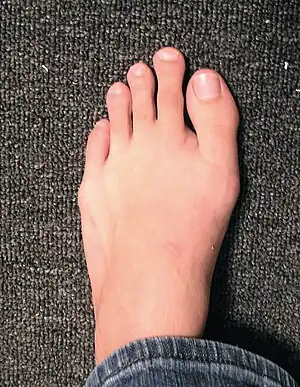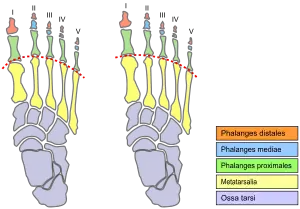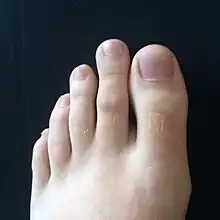Morton's toe
Morton's toe is the condition of having a first metatarsal bone that is shorter than the second metatarsal (see diagram). It is a type of brachymetatarsia.[1] This condition is the result of a premature closing of the first metatarsal's growth plate, resulting in a short big toe, giving the second toe the appearance of being long compared to the first toe.
| Morton's toe | |
|---|---|
| Other names | Morton's foot, Greek foot, royal toe, LaMay toe, Sheppard's toe, Coup d’etoe, Viking toe, Morton's syndrome,[1] long toe, boss toe |
 | |
| A Morton's toe that is so severe the second and third toe appear longer than the first toe. | |
 | |
| Dorsal surface of a right foot with Morton's toe (left image) and without (right image). The dashed line highlights joint position. Metatarsals in yellow. | |
| Specialty | Orthopedic |
| Symptoms | A big toe that is short compared to the second toe |
| Usual onset | Birth |
| Duration | Life-long |
| Frequency | 22% of the world population [2] |
The metatarsal bones behind the toes are of different lengths, and the relative lengths vary between people. For most feet, a smooth curve can be traced through the joints at the bases of the toes (the metatarsal-phalangeal, or MTP, joints). But in Morton's foot, the line has to bend more sharply to go through the base of the big toe, as shown in the diagram. This is because the first metatarsal, behind the big toe, is short compared to the second metatarsal, next to it. The longer second metatarsal puts the MTP joint at the base of the second toe further forward.
If the big toe and the second toe are the same length (as measured from the MTP joint to the tip, including only the toe bones or phalanges), then the second toe will protrude farther than the big toe, as shown in the photo. If the second toe is shorter than the big toe, the big toe may still protrude the furthest, or there may be little difference.
Presentation

The most common symptom experienced due to Morton's toe is callusing and/or discomfort of the ball of the foot at the base of the second toe. The first metatarsal head (toeward end of the metatarsal, at the base of the big toe) would normally bear the majority of a person's body weight during the propulsive phases of gait, but because the second metatarsal head is farthest forward, the force is transferred there. Pain may also be felt in the arch of the foot, at the ankleward end of the first and second metatarsals.[3]
In shoe-wearing cultures, Morton's toe can be problematic. For instance, wearing shoes with a profile that does not accommodate a longer second toe may cause foot pain. A small (80-person) study[4] found no statistically significant difference in the frequency of longer second toes between people with and without ingrown toenails, but tight and ill-fitting shoes are generally considered to increase the risk of ingrown toenails,[4][5] and shoes are often too tight on the toes.[6] A tight shoe toe box can also cause hammer toes.[7][8]
Associated condition
Among the issues associated with Morton's toe is that the weight distribution causes the front of the foot to widen as the weight shifts from the first shortened toe to the others. Regular shoes will often cause metatarsalgia and neuromas as the shoe pushes together the toes hence the case of Morton's neuroma. Wide shoes are recommended.
Treatment
Asymptomatic anatomical variations in feet generally do not need treatment.[9] Conservative treatment for foot pain with Morton's toe may involve exercises[10] or placing a flexible pad under the first toe and metatarsal;[3] an early version of the latter treatment was once patented by Dudley Joy Morton.[11] Restoring the Morton's toe to normal function with proprioceptive orthotics can help alleviate numerous problems of the feet such as metatarsalgia, hammer toes, bunions, Morton's neuroma, plantar fasciitis and general fatigue of the feet. Rare cases of disabling pain are sometimes treated surgically.
Prevalence
Morton's toe is a minority variant of foot shape. Its recorded prevalence varies in different populations, with estimates from 2.95% to 22%.[9][4] A study by the Bulgarian Academy of Sciences found that it is far more prevalent among Bulgarians.[12] Another study on the Idoma people of Nigeria found almost a third of people have it.[13]
Etymology
The name derives from American orthopedic surgeon Dudley Joy Morton (1884–1960),[14] who originally described it as part of Morton's triad, also known as Morton's syndrome or Morton's foot syndrome.[1] It is a congenital short first metatarsal bone, a hypermobile first metatarsal segment, and calluses under the second and third metatarsals. Confusion has arisen from "Morton's foot" being used for a different condition, Morton's metatarsalgia, which affects the space between the bones and is named after Thomas George Morton (1835–1903).[15]
Culture
Morton's toe, especially the second-toe-is-longer versions, has a long association with disputed anthropological and ethnic interpretations. Morton called it Metatarsus atavicus, considering it an atavism recalling prehuman grasping toes. In statuary and shoe fitting, a more-protuberant second toe has been called the Greek foot (as opposed to the Egyptian foot, where the great toe is longer).[16]
It was an idealized form in Greek sculpture (modern Greeks have an increased prevalence of Greek foot[17]), and this persisted as an aesthetic standard through Roman and Renaissance periods and later on in neo-classical works such as on the Statue of Liberty which has toes of this proportion.[18] Some famous Classical and Renaissance art works featuring Morton's toe include Boxer at Rest, The Birth of Venus, Laocoön and His Sons and Diana of Versailles.[19][20][21]
There are also associations found within Celtic groups. The French call it commonly pied grec (just as the Italians call it piede greco) but sometimes pied ancestral or pied de Néanderthal.[16]
See also
- Digit ratio
- Foot
- Runner's toe, repetitive injury seen in runners
References
- Schimizzi, A; Brage, M (September 2004). "Brachymetatarsia". Foot Ankle Clin. 9 (3): 555–70, ix. doi:10.1016/j.fcl.2004.05.002. PMID 15324790.
- "What is Morton's Toe". News-Medical.net. 2016-03-24. Retrieved 2022-02-03.
- Decherchi, Patrick (2005). "Dudley Joy Morton's foot syndrome". Presse Médicale. 34 (22 Pt 1): 1737–40. doi:10.1016/S0755-4982(05)84262-9. PMID 16374398.
- Ogawa R, Hyakusoku H (2006). "Does Egyptian foot present an increased risk of ingrown toenail?". Plastic and Reconstructive Surgery. 117 (6): 2111–2112. doi:10.1097/01.prs.0000214750.33936.45. PMID 16652022.
- Gibbs RC (1985). "Toe nail disease secondary to poorly fitting shoes or abnormal biomechanics". Cutis. 36 (5): 399–400. PMID 4064760.
- d'Août, K.; Pataky, T.C.; De Clercq, D.; Aerts, P. (2009). "The effects of habitual footwear use: Foot shape and function in native barefoot walkers†". Footwear Science. 1 (2): 81–94. doi:10.1080/19424280903386411. S2CID 56238052.
- Ellington, JK (December 2011). "Hammertoes and clawtoes: proximal interphalangeal joint correction". Foot and Ankle Clinics. 16 (4): 547–58. doi:10.1016/j.fcl.2011.08.010. PMID 22118228.
- Publishing, Harvard Health (12 December 2014). "Hammertoe". Harvard Health.
- Young, Craig C.; Niedfeldt, Mark W.; Morris, George A.; Eerkes, Kevin J. (2005). "Clinical Examination of the Foot and Ankle" (PDF). Primary Care: Clinics in Office Practice. 32 (1): 105–132. doi:10.1016/j.pop.2004.11.002. PMID 15831315. Archived from the original (PDF) on 2017-05-17. Retrieved 2016-01-25.
- Yoo, Won-gyu (2014). "Effect of the Intrinsic Foot Muscle Exercise Combined with Interphalangeal Flexion Exercise on Metatarsalgia with Morton's Toe". Journal of Physical Therapy Science. 26 (12): 1997–1998. doi:10.1589/jpts.26.1997. PMC 4273076. PMID 25540516.
- "Means for compensating for foot abnormalities". freepatentsonline.com. Retrieved 13 November 2016.
- Marinova, Desislava, Meglena Angelova, and Veselina Zhekova. "Morton's toe Frequency among the Bulgarian Population and its Association with High Arched Foot." Acta morphologica et anthropologica 29: 1-2.
- Aigbogun, Eric Osamudiamwen, et al. "Morton's toe: Prevalence and inheritance pattern among Nigerians." International Journal of Applied and Basic Medical Research 9.2 (2019): 89.
- Morton's syndrome (Dudley Joy Morton) at Who Named It?
- http://www.whonamedit.com/doctor.cfm/2324.html Thomas George Morton
- Kuhn, H; Gerdes-Kuhn, R; Küster, H.-H. (November 2003). "Zur Historie der Civinini-Durlacher-Neuropathie, genannt Morton Metatarsalgie". Fuss & Sprunggelenk.
- Noutsou, Polyxeni; Vounotrypidis, Periklis (April 2015). "The Greek Foot: Is it a Myth or Reality? An Epidemiological Study in Greece and Connections to Past and Modern Global History". Rheumatology. 54.
- Harrison, Marissa A. (2010). "An exploratory study of the relationship between second toe length and androgen-linked behaviors". Journal of Social, Evolutionary, and Cultural Psychology. 4 (4): 241–253. doi:10.1037/h0099286.
- The History of Ancient Art Volumes 1-2. University of Minnesota. 2012. p. 489.
- "Why do many Greek sculptures or Renaissance paintings have people with extra-long second toes". Cultura Colectiva. 17 August 2022.
- "The Story Behind the "Greek Foot" and its Medical Explanation". Greek Reporter.
Sources
- Morton, D. J. "Metatarsus atavicus: the identification of a distinct type of foot disorder", The Journal of Bone and Joint Surgery, Boston, 1927, 9: 531-544.
- Toes, relative lengths of first and second Online Mendelian Inheritance in Man.
- EFORT – European Federation of National Associations of Orthopaedics and Traumatology: Scientific Library: Concepts of the human foot in mythology, art and surgery, John Kirkup, EFORT (Bulletin of European Orthopaedics), #11, Nov. 1999.
- "British feet" Discover Magazine, June, 1996, Retrieved June, 2021.
- Fett, HC; Pool, CC (1949). "Plantar interdigital neuroma or Morton's toe". American Journal of Surgery. 78 (4): 522–5. doi:10.1016/0002-9610(49)90218-4. PMID 18141198.